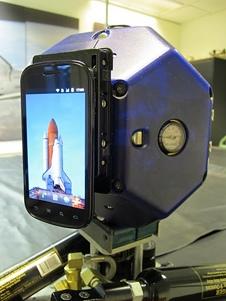Android and iPhone ride to ISS on Atlantis

Two rival smartphones — the Android-powered Nexus S and the iPhone 4 — have taken a ride on the space shuttle Atlantis to the International Space Station, where they will be tested out for use in future space exploration.

A Nexus S smartphone has flown up to the International Space Station on Atlantis as part of an experiment involving satellites developed by MIT. Photo credit: Nasa
Samsung's Nexus S is aboard Nasa's final shuttle mission for an experiment involving miniature satellites developed by the Massachusetts Institute of Technology. In the experiment, the smartphone will be attached to three bowling ball-sized Synchronized Position Hold, Engage, Reorient, Experimental Satellites (Spheres), which have been on the International Space Station (ISS) since 2006.
"By connecting a smartphone, we can immediately make Spheres more intelligent," DW Wheeler, a lead engineer in Nasa's Intelligent Robotics Group, said in a statement from Google and Samsung on Friday. "With a smartphone, the Spheres will have a built-in camera to take pictures and video, sensors to help conduct inspections, a powerful computing unit to make calculations and a Wi-Fi connection that we will use to transfer data in real time to the space station and mission control."
The addition of a Nexus S turns the Spheres into remote-controlled robots that can survey and inspect the space station, according to Samsung and Google. Nasa hopes that intelligence gleaned from the Sphere experiments could one day lead to better autonomous docking and feed into ongoing research into clusters of many small satellites.
"The availability of the Android source code allows us to customise the smartphone to be used as a compact, low-cost, low-power computer, rather than just as a phone," said Mark Micire, a software engineer in Nasa's Intelligent Robotics Group. "In the future, you are going to see smartphones used for all sorts of embedded processing applications, from robotics to sensor networks and equipment control."
Another handset hitching a ride on Atlantis's STS-135 mission was Apple's iPhone 4. The smartphone is loaded with Odyssey Space Research's SpaceLab for iOS application, and the two will be tested as a potential space navigation tool, Nasa said. The experiment will see how the iPhone performs in estimating altitude, calibrating spacecraft instruments and updating navigation data, using its gyroscope, camera, accelerometer and chip.
"The experiment is part of a long-term effort to test off-the-shelf products, including the latest in consumer platforms, in the spaceflight environment," Nasa said in a mission statement.
In January, Surrey Satellite Technology announced plans to launch a smartphone-bearing satellite. At the time the company said it hoped to use the smartphone — most likely a Nexus One, Galaxy S or LG Optimus Black — to gather avionics data about the satellite.
Get the latest technology news and analysis, blogs and reviews delivered directly to your inbox with ZDNet UK's newsletters.